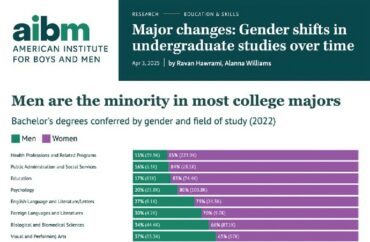
‘… we can do more for men without doing less for women and girls,’ organizer says
A new partnership between nearly two dozen colleges and universities aims to tackle the steep decline in male enrollment — an effort that is very much needed, two scholars told The College Fix.
In a stark shift in higher education demographics, men are now earning two of every five college degrees, and are more likely than women to drop out of college. These trends are highlighted in a recent report from the University of Tennessee at Knoxville and the American Institute for Boys and Men.
With college enrollment dropping and men making up the vast majority of that decline, the university and institute decided to launch the Higher Education Male Achievement Collaborative in October.
The initiative provides a platform for collaboration among colleges, academic leaders, and nonprofit organizations and offers resources, webinars, and an annual summit. Currently, 21 colleges and universities are participating, according to a news release.
“Our goal with HEMAC is to ensure that every student has the opportunity to thrive, and we firmly believe that we can do more for men without doing less for women and girls,” Richard Reeves, founding president of the American Institute for Boys and Men, said in a news release. He did not respond to The Fix‘s requests for comment.
Meanwhile, Edward Bartlett, president of SAVE, told The College Fix this is the first initiative of its kind that he is aware of. His organization focuses on fairness and due process for men, especially on college campuses.
“The HEMAC is an important and meaningful effort to focus on the challenges facing men in higher education,” Bartlett said via email.
“Men are also deserving of ‘gender equality,’” he told The Fix, highlighting the importance of addressing the achievement gap for male students.
“Male enrollments in higher education have been declining for many years, partly due to scholarship programs that explicitly discriminate against men,” Bartlett told The Fix. “HEMAC will bring public attention to this crisis.”
The collaborative aims to shed light on systemic issues that contribute to the decline in male achievement, according to organizers.

For example, a study published in April through the institute found that many traditionally male-dominant majors like engineering and computer science have become “less male”; meanwhile, others that are more traditionally “female” like English and psychology have become even “more female.”
Sean Kullman, co-author of the book “Boys, A Rescue Plan: Moving Beyond the Politics of Masculinity to Healthy Male Development,” emphasized the need for a targeted focus on male students in an interview with The Fix.
“The Higher Education Male Achievement Collaborative (HEMAC) is a step in the right direction because males of all races are behind their female counterparts—and often across racial lines—in college enrollment and graduation rates,” Kullman said in a recent email.
He pointed to research conducted in collaboration with the Pell Institute and U.S. Census Bureau, which analyzed data from 161 million dependent family members aged 18 to 24.
The research “revealed that black, white, and Hispanic males were lagging behind their female counterparts of all races in terms of college participation, with the only exception being Asian males. Black, Hispanic, and white male participation rates were statistically similar, so the issue appears to be more sex-based than anything else,” Kullman said.
Kullman also said there is a need for earlier intervention in the K-12 education system, because the challenges boys face in higher education often stem from educational practices that do not account for brain-sex differences.
“It’s not that teachers don’t care; it’s that they need help learning best practices that encourage a brain-sex approach to teaching,” he told The Fix.
He further noted, “Parents and teachers instinctively know boys and girls are different and have different needs—yet it’s something our culture seems uncomfortable addressing in the classroom.”
Kullman said he believes that a more effective approach in K-12 education would help boys stay engaged, which could ultimately improve their college success.
MORE: Scholars at Harvard conference warn ‘biased’ AI could define ‘woman’
IMAGE CAPTION AND CREDIT: A male student sits around several female students in a college classroom. Gorodenkoff/Shutterstock, American Institute for Boys and Men/Facebook
Like The College Fix on Facebook / Follow us on Twitter






Please join the conversation about our stories on Facebook, Twitter, Instagram, Reddit, MeWe, Rumble, Gab, Minds and Gettr.